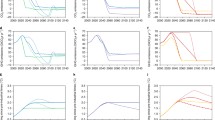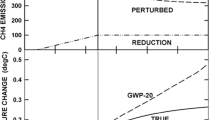Abstract
The use of Global Warming Potentials (GWPs) to calculate ‘equivalent’ carbon dioxide emissions reductions in the climate change context is examined. We find that GWPs are accurate only for short time horizons. Over long time horizons their use implicitly leads to tradeoffs between near-term and long-term climate change. For one of the most policy-relevant cases, comparing reductions in methane and carbon dioxide, the long-term effect on climate of reducing methane emissions is relatively small, at variance with the common perception based on published GWP values.
Similar content being viewed by others
References
Albritton, D. L., Derwent, R. G., Isaksen, I. S. A., Lal, M., and Wuebbles, D. J.: 1995, ‘Trace Gas Radiative Forcing Indices’, in Houghton, J. T., Meira Filho, L. G., Bruce, J., Lee, H., Callander, B. A., Haites, E., Harris, N., and Maskell, K. (eds.), Climate Change 1994: Radiative Forcing of Climate Change and an Evaluation of the IPCC IS92 Emissions Scenarios, Cambridge University Press, Cambridge, U.K., pp. 205-231.
Atkinson, G. and Hamilton, K.: 1996, ‘Accounting for Progress: Indicators for Sustainable Development’, Environment 38 (7), 16-20, 40-44.
Caldeira, K. and Kasting J. F.: 1993 ‘Insensitivity of Global Warming Potentials to Carbon Dioxide Emission Scenarios’, Nature 366, 251-253.
Eckaus, R. S.: 1992, ‘Comparing the Effects of Greenhouse Gas Emissions on Global Warming’, Energy J. 13, 25-35.
Enting, I. G., Wigley, T. M. L., and Heimann, M.: 1994, CSIRO Division of Atmospheric Research, Technical Paper No. 31.
Fisher, C. R., Hales, C., Wang, W. C., Ko, M., and Sze, N.: 1990, ‘Model Calculations of the Relative Effects of CFCs and their Replacements on Global Warming’, Nature 344, 513-516.
Hammitt, J. K., Jain, A. K., Adams, J. L., and Wuebbles, D. J.: 1996, ‘A Welfare-Based Index for Assessing Environmental Effects of Greenhouse-Gas Emissions’, Nature 381, 301-303.
Hansen, J., Sato, M., and Ruedy, R.: 1997. ‘Radiative Forcing and Climate Response’, JGR 102 (D6), 6831-6864.
Harvey, L. D. D.: 1993, ‘A Guide to Global Warming Potentials (GWPs)’, Energy Pol. 21, 24-34.
Kandlikar, M.: 1995, ‘The Relative Role of Trace Gas Emissions in Greenhouse Abatement Policies’, Energy Pol. 23, 879-883.
Kattenberg, A. et al.: 1996, in Houghton, J. T. et al. (eds.), Climate Change 1995: The Science of Climate Change, Contribution of Working Group I to the Second Assessment Report of the Intergovernmental Panel on Climate Change, Cambridge University Press, Cambridge, U.K., pp. 285-357.
Lashof, D. A. and Ahuja, D. R.: 1990, ‘Relative Contributions of Greenhouse Gas Emissions to Global Warming’, Nature 344, 529-531.
Leggett, J. A., Pepper, W. J., and Swart, R. J.: 1992, in Houghton, J. T., Callander, B. A., and Varney, S. K. (eds.), Climate Change, 1992. The Supplementary Report to the IPCC Scientific Assessmentt, Cambridge Univ. Press, Cambridge, U.K., pp. 69-95.
Lind, R. C. et al.: 1982, Discounting for Time and Rick in Energy Policy. Resources for the Future, Dist. Johns Hopkins University Press, Baltimore.
Osborn, T. J. and Wigley, T. M. L.: 1994, ‘A Simple Model for Estimating Methane Concentration and Lifetime Variations’, Clim. Dyn. 9, 181-193.
Raper, S. C. B. and Cubasch, U.: 1996, ‘Emulation of the Results from a Coupled General Circulation Model Using a Simple Model’, Geophys. Res. Lett. 23, 1107-1110.
Raper, S. C. B., Wigley, T. M. L., and Warrick, R. A.: 1996, ‘Global Sea Level Rise: Past and Future’, in Milliman, J. D. and Haq, B. U. (eds.), Sea-Level Rise and Coastal Subsidence: Causes, Consequences and Strategies, Kluwer Academic Publishers, Dordrecht, pp. 11-45.
Rodhe, H.: 1990, ‘A Comparison of the Contribution of Various Gases to the Greenhouse Effect’, Science 248, 1217-1219.
Rogers, J. D. and Stephens, R. D.: 1988, ‘Absolute Infrared Intensities for F-113 and F-114 and an Assessment of their Greenhouse Warming Potential Relative to Other Cloroflurocarbons’, J. Geophys. Res. 93, 2423-2428.
Rotmans, J. and Den Elzen, M. G. J.: 1992, ‘A Model-Based Approach to the Calculation of Global Warming Potentials (GWP)’, Int. J. Climatol. 12, 865-874.
Schimel, D. S. et al.: 1996, ‘CO2 and the Carbon Cycle’, in Houghton, J. T. et al. (eds.), Climate Change 1995: The Science of Climate Change, Contribution of Working Group I to the Second Assessment Report of the Intergovernmental Panel on Climate Change, Cambridge University Press, Cambridge, U.K., pp. 65-86.
Schmalensee, R.: 1993, ‘Comparing Greenhouse Gases for Policy Purposes’, Energy J. 14, 245-255.
Shackley, S. and Wynne, B.: 1997, ‘Global Warming Potentials: Ambiguity or Precision as an Aid to Policy?’, Clim. Res. 8, 89-106.
Shine, K., Derwent, R. G., Wuebbles, D. J., and Morcrette, J. J.: 1990, ‘Radiative Forcing of Climate’, in Houghton, J. T. et al. (eds.), Climate Change: The IPCC Scientific Assessment, Cambridge University Press, Cambridge, U.K., pp. 41-68.
Smith, S. J.: 1996, ‘Comparing Greenhouse Gases: Equivalence, Indexes, and the Comprehensive Approach’, Final report to AAAS (AAAS Directorate for Science and Policy Programs, Washington, D.C.).
Smith, S. J. and Wigley, T. M. L.: 2000, ‘Global Warming Potentials: 2. Accuracy’, Clim. Change (this issue; SW2000).
Stewart, R. B. and Wiener, J. B.: 1992. ‘The Comprehensive Approach to Global Climate Policy: Issues of Design and Practicality’, Arizona J. Int. Compar. Law 9, 83-113.
U.S. EPA: 1994, Inventory of U.S. Greenhouse Gas Emissions and Sinks: 1990-1993, EPA-230-R-94-014, Environmental Protection Agency, Washington, D.C.
U.S.: 1997, Climate Action Report: Submission of the United States of America under the United Nations Framework Convention on Climate Change, State Dept. Publication 10996, Washington, D.C.
Wang, W. C., Dudek, M. P., Liang, X. Z., and Kiehl, J. T.: 1991. ‘Inadequacy of Effective CO2 as a Proxy in Simulating the Greenhouse Effect of Other Radiatively Active Gases’, Nature 350, 573-577.
Warrick, R. A. et al.: 1996, ‘Changes in Sea Level’, in Houghton, J. T. et al. (eds.), Climate Change 1995: The Science of Climate Change, Contribution of Working Group I to the Second Assessment Report of the Intergovernmental Panel on Climate Change, Cambridge University Press, Cambridge, U.K., pp. 359-406.
Wiener, J. B.: 1995, ‘Protecting the Global Environment’, in Graham, J. D. and Wiener, J. B. (eds.), Risk Versus Risk: Tradeoffs in Protecting Health and the Environment, Harvard University Press, Cambridge, MA, pp. 193-225.
Wigley, T.M. L. and Raper, S. C. B.: 1992, ‘Implications for Climate and Sea Level of Revised IPCC Emissions Scenarios’, Nature 357, 293-300.
Wigley, T. M. L. and Reeves, C.: 1991, ‘Global Warming Potentials’, Report to the U.K. Department of the Environment, London.
Wigley, T. M. L., Hulme, M., and Holt, T.: 1990, ‘An Alternative Approach to Calculating Global Warming Potentials’, Workshop on the Scientific Basis of Global Warming Potential Indices, Boulder, Colorado, Nov. 14-15, 1990.
Wigley, T.M. L.: 1993, ‘Balancing the Carbon Budget. Implications for Projections of Future Carbon Dioxide Concentration Changes’, Tellus 45B, 409-425.
Wigley, T. M. L.: 1998, ‘The Kyoto Protocol: CO2, CH4 and Climate Implications’, Geophys. Res. Lett. 25, 2285-2288.
WMO: 1991, Scientific Assessment of Ozone Depletion: 1991, World Meteorological Organization.
Wuebbles, D.: 1981, ‘The Relative Efficiency of a Number of Halocarbons for Destroying Stratospheric Ozone’, UCID-18924, Lawrence Livermore National Laboratory, Livermore.
Wuebbles, D. J., Jain, A. K., and Grant, K. E: 1995, ‘Sensitivity of Direct Global Warming Potentials to Key Uncertainties’, Clim. Change 29, 265-297.
Author information
Authors and Affiliations
Rights and permissions
About this article
Cite this article
Smith, S.J., Wigley, M.L. Global Warming Potentials: 1. Climatic Implications of Emissions Reductions. Climatic Change 44, 445–457 (2000). https://doi.org/10.1023/A:1005584914078
Issue Date:
DOI: https://doi.org/10.1023/A:1005584914078




